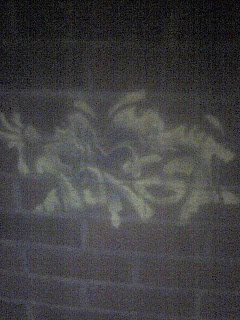Like Snyder writes in his book, Graffiti Lives, I do not think class, status, ethnicity, etc., has anything to do with who is "writing." Anyone can like writing.
Some people do it for fame; Synder writes that "[TAKI 183] made it clear what writing was all about: fame" (pg 23). TAKI wrote his name in strategic places and eventually was in the New York Times.
Others do have a message to tell and were inspired by politics. Snyder writes that, indeed, "...graffiti... served those who wished to influence public opinion about the culture and its practitioners" (pg. 28).
And then there are the others who do it for art. Some writers have "turned their youthful graffiti success into adult careers as muralists for hire, tattoo artists, graphic designers, and magazine publishers" (pg. 44).
For whatever reason writers do it, though, it is always an expression of themselves which is why it is called writing.
My dad was recently in Champaign, Illinois. Timing really could not have been more perfect. Let me explain: He loves trains and said how there was one near where he was staying. This gave me the idea to ask him to take pictures for me if there was any graffiti nearby since graffiti was very popular around trains back in the 60's and 70's according to Graffiti Lives and Style Wars. Lucky for me, there was graffiti! I think the following pictures do prove my theory of why writers write. For instance, this first picture shows the graffiti is near a train-- because so many people will ride by, the graffiti will have a lot of exposure. This gives fame. One can tell that some of the graffiti was done specifically for the riders, as well, since one throw-up says "Rider," unless that is someone's alias, of course. There are also a lot of tags all over the place, even on top of "Rider,"-- putting your tag up around a city as many times as you can gives you exposure, as well.
This next picture says "No war" showing that some people do it because they are politically inspired.
This last picture from Illinois I think shows that graffiti is an expression of oneself. Someone has written "I 'heart' (someone/something I can't discern)" which is obviously an expression of one's feelings for the world to see.
Does the writing define the writer, and if so, how? What relationship might these materials and spaces have to the writer and the writing? What counts as graffiti?
I do not think the writing necessarily defines the writer. For one thing, sometimes only the writer can understand his/her work. Others can only wish to come close to the true meaning of the writing. I can honestly say that I do not understand graffiti's meanings, although I can do take stabs at the meanings. Snyder also notes that it helps if one is an "insider" to understand meanings better-- the "writers... would often decipher the unique style of graffiti, which are difficult for outsiders to read" (pg. 15).
I think that these graffiti places in Illinois seem somewhat desolate. It is almost a win-win situation: no one will catch you doing graffiti and the trains going by helps get exposure. I do think that most people try to get their graffiti up in places with a lot of people and a place, as Snyder notes, wth little chance of removal. Fame is something that most people want. It is sad to think that someone does a "piece" and no one ever sees it.
-------------------------------------------------------------------------------------------------
I walked around Mason Saturday night as it began to snow. I only found one graffiti there and I'm not quite sure what it is. I believe it's a tag, just in "Wildstyle" since I can't read it. It was going up the million steps to the John Center on a brick wall. The picture quality is not good since I took it at night:
I believe there is not a lot of graffiti at Mason because it would just get removed. Additionally, it is a place of "authority." People feel like the place is kept clean so there is less desire to add graffiti, whereas that place in Illinois has so much graffiti that one might as well add to it. Snyder writes that Jeff Ferrell, in Crimes of Style, creates a theory that "graffiti... upsets the 'aesthetics of authory' embedded in a clean wall that is meant to inspire order" (pg. 30).
Finally, I want to change the connotation of graffiti. Most people see graffiti as ink, aerosol cans, etc. As it was snowing Saturday night, I decided to create some of my own graffiti. I did not have any aerosol cans or ink, though, but I had a better idea! Observe:
Do you know what this is? Well, snow covered one of the tables outside of the Johnson Center. I used my finger and drew a smiley face, then signed it with my alias. I think it counts as defacing property, or maybe I am just full of myself. Either way, I think I found a way to do "graffiti" that does not involve ink and is not permanent. This helped me realize "what counts as graffiti"-- it can be anything that is not meant to be there by who owns the property. Or, in the case of legal walls, anything that is an expression of oneself that may be viewed by whoever passes by.





No comments:
Post a Comment